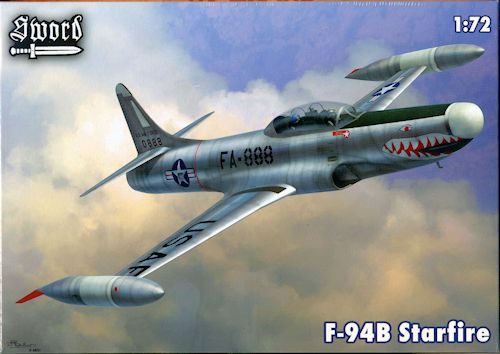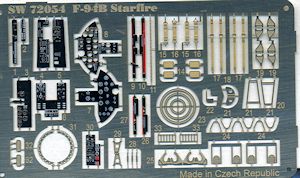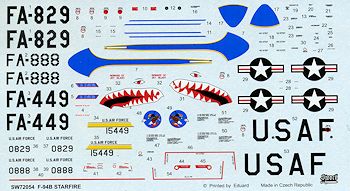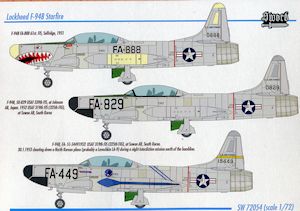
| KIT #: | SW 72054 |
| PRICE: | $32.99 SRP |
| DECALS: | Three options |
| REVIEWER: | Scott Van Aken |
| NOTES: |

| HISTORY |
Built to a 1948 USAF specification for a radar-equipped interceptor to replace the aging F-61 Black Widow and North American F-82 Twin Mustang, it was specifically designed to counter the threat of the USSR's new Tupolev Tu-4 bombers (reverse-engineered Boeing B-29). The Curtiss-Wright XF-87 Blackhawk had been designated to be the USAF first jet night fighter, but its performance was sub par, and Lockheed was asked to design a jet night fighter on a crash program basis. The F-94 was derived from the TF-80C (later T-33A Shooting Star) which was a two-seat trainer version of the F-80 Shooting Star. A lengthened nose area with guns, radar and automatic fire control system was added. Since the conversion seemed so simple, a contract was awarded to Lockheed in early 1949, with the first flight on 16 April 1949. The early test YF-94s used seventy-five percent of the parts used in the earlier F-80 and T-33As.
The fire control system was the Hughes E-1, which incorporated an AN/APG-33 radar (derived from the AN/APG-3 which directed the Convair B-36's tail guns) and a Sperry A-1C computing gunsight. This short-range radar system was useful only in the terminal phases of the interception, most of the operation would be directed using ground-controlled interception as was the case with the earlier aircraft it replaced.
The added weight of the electronic equipment soon dictated that a more powerful engine be fitted, the afterburning Allison J33-A-33 centrifugal-type turbojet replacing the standard J-33 fitted to the T-33A. The F-94 was to be the first US production jet with an afterburner. The J33-A-33 had standard thrust of 4,000 pounds-force (18 kN), and with water injection this was increased to 5,400 pounds-force (24 kN) and with afterburning a maximum of 6,000 pounds-force (27 kN) thrust. The combination of the new, larger engine and the electronics gear reduced the internal fuel capacity. The YF-94A's afterburner had many teething problems with its igniter and the flame stabilization system.
The initial model was the F-94A. Its armament was four .50 in (12.7 mm) M3 Browning machine guns mounted in the fuselage with the muzzles exiting just behind the radome. Two 165 US Gallon (1,204 litre) drop tanks, as carried by the F-80 and T-33, could be carried under the wingtips. Alternatively, these could be replaced by 1,000 lb (454 kg) bombs, giving the aircraft a secondary fighter bomber role. 109 were produced. The subsequent F-94B, which entered service in January 1951, had upgraded and more reliable electronics and engines, as well as a new ILS. 356 of these were built.
| THE KIT |
 With many of the parts for this kit being the same as on their T-33s and F-80s, Sword does not have to reinvent the wheel every time it does a variant on those planes. Doesn't mean it uses the same sprues, but it does mean that much of the work on wings, landing gear and such has already been done, making it easier to get the molds ready.
With many of the parts for this kit being the same as on their T-33s and F-80s, Sword does not have to reinvent the wheel every time it does a variant on those planes. Doesn't mean it uses the same sprues, but it does mean that much of the work on wings, landing gear and such has already been done, making it easier to get the molds ready.
This kit is so very typical of short run kits today with very nicely detailed parts in terms of external detail. A single sprue that has been cut to fit into the box makes up the airframe with a clear sprue for the windscreen, canopy and landing light. A very nicely done color photo etch fret by Eduard takes care of the rest of the parts. No resin on this one.
 Photo etch is used mostly for the interior pieces such as the bits for the seat, instrument panels, side consoles, placards and mirrors as well as the inside canopy frame. On the outside, it is used for gear door struts, oleo scissors, speed brake struts, the vents just atop the intakes, and some exhaust bits.
Photo etch is used mostly for the interior pieces such as the bits for the seat, instrument panels, side consoles, placards and mirrors as well as the inside canopy frame. On the outside, it is used for gear door struts, oleo scissors, speed brake struts, the vents just atop the intakes, and some exhaust bits.
For optional bits, the speed brakes can be posed closed, but these pretty much always bled down once the power was removed. The canopy can be posed open or closed and that is pretty much it. Since most of the photo etch is for the cockpit, you'll spend quite a bit of time getting it together. The instructions state that the interior is pretty much interior green. The nose gear well is made up of three parts and is a separate bit to the interior. There is room for weight in the nose and you will need it. The intakes are dealt with just like on the F-80 in that there is a very long piece attached to the splitter that makes up one wall with the cockpit making up the other. It ends in a blanking plate. The outside of the intake is split between the fuselage and the lower wing section, making a seam that is difficult to clean up. A single piece wheel well fits into the lower wing section.
Tip tanks are in two halves and are a butt fit to the ends of the assembled wings. Landing gear is fairly nicely detailed and there are separate wheels on all three. As mentioned, the canopy can be posed open and it fits over framework that allows for fitment of the actuating arm. One thing that I did not see in the kit were the wing gun pods that were sometimes carried by the F-94B, though that may have been a post war addition.
 Instructions ar
Instructions ar e well drawn and a bit crowded in a few spots. Generic color information is provided. There are markings for three planes. One is the box art plane from the 61st FIS. Markings guide states that the center of the tip tanks is white with the radomes being ivory. The fins on the tip tanks are red. Next is a rather generic looking Korean war plane from the 319 FIS at Suwon in 1952. Finally, a plane that achieved a night kill over an La-9 is another 319 FIS plane. This time there is come nice color in terms of blue on the tip tanks and fuselage stripes with a yellow tail band. The decal sheet is nicely printed by Eduard and includes a full stencil suite. To my eyes the USAF and insignia seem a bit thin. The sheet also does not include black wing walks or nose anti-glare panel so you will need to paint those yourself.
e well drawn and a bit crowded in a few spots. Generic color information is provided. There are markings for three planes. One is the box art plane from the 61st FIS. Markings guide states that the center of the tip tanks is white with the radomes being ivory. The fins on the tip tanks are red. Next is a rather generic looking Korean war plane from the 319 FIS at Suwon in 1952. Finally, a plane that achieved a night kill over an La-9 is another 319 FIS plane. This time there is come nice color in terms of blue on the tip tanks and fuselage stripes with a yellow tail band. The decal sheet is nicely printed by Eduard and includes a full stencil suite. To my eyes the USAF and insignia seem a bit thin. The sheet also does not include black wing walks or nose anti-glare panel so you will need to paint those yourself.
| CONCLUSIONS |
WelPrevious to this, the only F-94A/B in this scale was one by Heller, which in the last few years has been very difficult to locate. It is a nice kit, but has raised detail and is a simpler kit to build with less detail. This one has all the detail you could want and while it will be more difficult to build due to all the photo etch and its short run nature, it will provide an excellent model when you are done.
| REFERENCES |
http://en.wikipedia.org/wiki/F-94_Starfire
May 2013
Thanks to Squadron Products for the preview kit. Get yours today at your local retailer.
If you would like your product reviewed fairly and quickly, please contact the editor or see other details in the